2016 September Cisco Official New Released 200-105 Dumps in Lead2pass.com!
100% Free Download! 100% Pass Guaranteed!
Lead2pass 200-105 braindumps including the exam questions and the answer, completed by our senior IT lecturers and the Cisco product experts, include the current newest 200-105 exam questions.
Following questions and answers are all new published by Cisco Official Exam Center: http://www.lead2pass.com/200-105.html
QUESTION 141
What is a valid HSRP virtual MAC address?
A. 0000.5E00.01A3
B. 0007.B400.AE01
C. 0000.0C07.AC15
D. 0007.5E00.B301
Answer: C
Explanation:
Hot Standby Router Protocol Features and Functionality http://www.cisco.com/en/US/tech/tk648/tk362/technologies_tech_note09186a0080094a91.shtml
HSRP Addressing
In most cases when you configure routers to be part of an HSRP group, they listen for the HSRP MAC address for that group as well as their own burned-in MAC address. The exception is routers whose Ethernet controllers only recognize a single MAC address (for example, the Lance controller on the Cisco 2500 and Cisco 4500 routers). These routers use the HSRP MAC address when they are the Active router, and their burned-in address when they are not.
HSRP uses the following MAC address on all media except Token Ring:
0000.0c07.ac** (where ** is the HSRP group number)
QUESTION 142
Lab Simulation Question – EIGRP 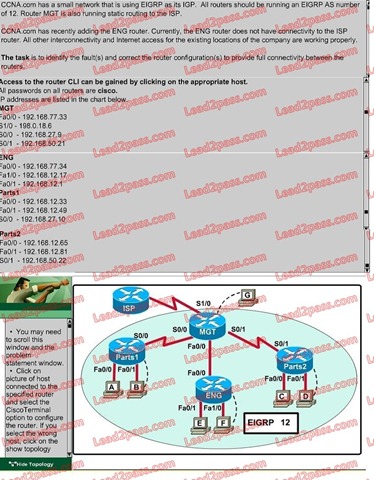
Answer:
First we should check the configuration of the ENG Router.
Click the console PC “F” and enter the following commands.
ENG> enable
Password: cisco
ENG# show running-config
Building configuration…
Current configuration : 770 bytes
!
version 12.2
no service timestamps log datetime msec
no service timestamps debug datetime msec
no service password-encryption
!
hostname ENG
!
enable secret 5 $1$mERr$hx5rVt7rPNoS4wqbXKX7m0
!
interface FastEthernet0/0
ip address 192.168.77.34 255.255.255.252
duplex auto
speed auto
!
interface FastEthernet0/1
ip address 192.168.60.65 255.255.255.240
duplex auto
speed auto
!
interface FastEthernet1/0
ip address 192.168.60.81 255.255.255.240
duplex auto
speed auto
!
router eigrp 22
network 192.168.77.0
network 192.168.60.0
no auto-summary
!
ip classless
!
line con 0
line vty 0 4
login
!
end
ENG#
From the output above, we know that this router was wrongly configured with an autonomous number (AS) of 22. When the AS numbers among routers are mismatched, no adjacency is formed.
(You should check the AS numbers on other routers for sure)
To solve this problem, we simply re-configure router ENG router with the following commands:
ENG# conf t
ENG(config)# no router eigrp 22
ENG(config)# router eigrp 222
ENG(config-router)# network 192.168.60.0
ENG(config-router)# network 192.168.77.0
ENG(config-router)# no auto-summary
ENG(config-router)# end
ENG# copy running-config startup-config
Second we should check the configuration of the MGT Router.
Click the console PC “G” and enter the following commands.
MGT> enable
Password: cisco
MGT# show running-config
Building configuration…
Current configuration : 1029 bytes
!
version 12.2
no service timestamps log datetime msec
no service timestamps debug datetime msec
no service password-encryption
!
hostname MGT
!
enable secret 5 $1$mERr$hx5rVt7rPNoS4wqbXKX7m0
!
interface FastEthernet0/0
ip address 192.168.77.33 255.255.255.252
duplex auto
speed auto
!
interface Serial0/0
ip address 192.168.36.13 255.255.255.252
clock rate 64000
!
interface Serial0/1
ip address 192.168.60.25 255.255.255.252
clock rate 64000
!
interface Serial1/0
ip address 198.0.18.6 255.255.255.252
!
interface Serial1/1
no ip address
shutdown
!
interface Serial1/2
no ip address
shutdown
!
interface Serial1/3
no ip address
shutdown
!
router eigrp 222
network 192.168.36.0
network 192.168.60.0
network 192.168.85.0
network 198.0.18.0
no auto-summary
!
ip classless
ip route 0.0.0.0 0.0.0.0 198.0.18.5
!
line con 0
line vty 0 4
login
!
end
MGT#
Notice that it is missing a definition to the network ENG. Therefore we have to add it so that it can recognize ENG router
MGT# conf t
MGT(config)# router eigrp 222
MGT(config-router)# network 192.168.77.0
MGT(config-router)# end
MGT# copy running-config startup-config
Now the whole network will work well. You should check again with ping command from router ENG to other routers!
In Short:
ENG Router
ENG>enable
Password: cisco ENG# conf t
ENG(config)# no router eigrp 22
ENG(config)# router eigrp 222
ENG(config-router)# network 192.168.60.0
ENG(config-router)# network 192.168.77.0
ENG(config-router)# no auto-summary
ENG(config-router)# end
ENG# copy running-config startup-config
MGT Router
MGT>enable
Password: cisco MGT# conf t
MGT(config)# router eigrp 222
MGT(config-router)# network 192.168.77.0
MGT(config-router)# end
MGT# copy running-config startup-config
Some Modification in Question
After adding ENG router, no routing updates are being exchanged between MGT and the new location. All other inter connectivity for the existing locations of the company are working properly. But Internet connection for existing location including Remote1 and Remote2 networks are not working.
Faults Identified:
1. Incorrect Autonomous System Number configured in ENG router.
2. MGT router does not advertise route to the new router ENG.
3. Internet Connection is not working all stations.
We need to correct the above two configuration mistakes to have full connectivity
Steps:
1. ENG Router: Change the Autonomous System Number of ENG
2. Perimiter Router: Add the network address of interface of Permiter that link between MGT and ENG.
3. Perimiter Router: Add default route and default-network.
Check the IP Address of S1/0 interface of MGT Router using show running-config command. (The interfaced used to connect to the ISP)
!
interface Serial1/0
ip address 198.0.18.6 255.255.255.252
!
For Internet sharing we have create a default route, and add default-network configuration. The IP address is 198.0.18.6/30. Then the next hop IP will be 198.0.18.5.
ENG Router
ENG>enable
Password: cisco ENG# conf t
ENG(config)# no router eigrp 22
ENG(config)# router eigrp 222
ENG(config-router)# network 192.168.60.0
ENG(config-router)# network 192.168.77.0
ENG(config-router)# no auto-summary
ENG(config-router)# end
ENG# copy running-config startup-config
MGT Router
MGT>enable
Password: cisco MGT# conf t
MGT(config)# router eigrp 222
MGT(config-router)# network 192.168.77.0
MGT(config-router)# exit
MGT(config)# ip route 0.0.0.0 0.0.0.0 198.0.18.5
MGT(config)# ip default-network 198.0.18.0
MGT(config)# exit
MGT# copy running-config startup-config
Important:
If you refer the topology and IP chart, the MGT router uses Fa0/0 to connect ENG router, S0/0 used to connect Remote1, and S0/1 used to connect Remote2.
Refer to the command show running-config, the command #PASSIVE-INTERFACE <Interface Name> will deny EIGRP updates to specified interface. In that case we need to use #no passive-interface <Interface Name> to allow the routing updates to be passed to that interface. For example when used the #show run command and we see the output like below.
!
router eigrp 22
network 192.168.77.0
network 192.168.60.0
passive-interface FastEthernet 0/0
passive-interface Serial 1/0
no auto-summary
!
Then the command would be
MGT(config)#router eigrp 222
MGT(config-router)#no passive-interface Fa0/0
MGT(config-router)#end
Also MGT router connect to the ISP router using Serial 1/0. If you seen passive-interface s1/0, then do not remove it using #no passive-interface s1/0 command.
QUESTION 143
Refer to the exhibit. How should the FastEthernet0/1 ports on the 2950 model switches that are shown in the exhibit be configured to allow connectivity between all devices? 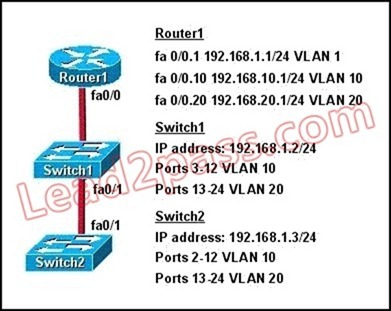
A. The ports only need to be connected by a crossover cable.
B. SwitchX(config)# interface fastethernet 0/1
SwitchX(config-if)# switchport mode trunk
C. SwitchX(config)# interface fastethernet 0/1
SwitchX(config-if)# switchport mode access
SwitchX(config-if)# switchport access vlan 1
D. SwitchX(config)# interface fastethernet 0/1
SwitchX(config-if)# switchport mode trunk
SwitchX(config-if)# switchport trunk vlan 1
SwitchX(config-if)# switchport trunk vlan 10
SwitchX(config-if)# switchport trunk vlan 20
Answer: B
QUESTION 144
Refer to the exhibit. A junior network engineer has prepared the exhibited configuration file.
What two statements are true of the planned configuration for interface fa0/1? (Choose two.) 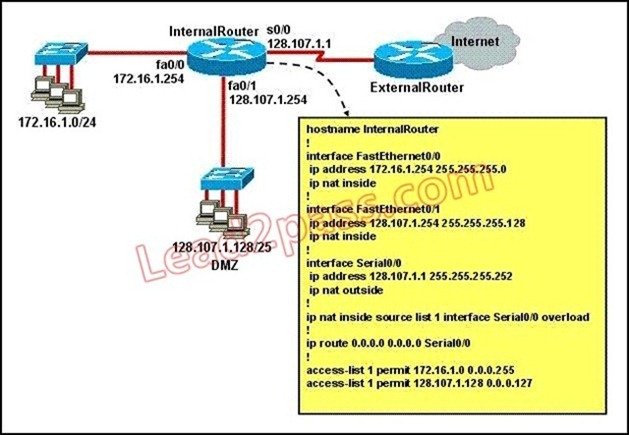
A. The two FastEthernet interfaces will require NAT configured on two outside serial interfaces.
B. Address translation on fa0/1 is not required for DMZ Devices to access the Internet.
C. The fa0/1 IP address overlaps with the space used by s0/0.
D. The fa0/1 IP address is invalid for the IP subnet on which it resides.
E. Internet hosts may not initiate connections to DMZ Devices through the configuration that is shown.
Answer: BE
QUESTION 145
Refer to the exhibit.
Which statement describes DLCI 17? 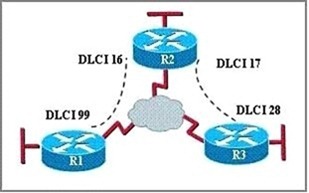
A. DLCI 17 describes the ISDN circuit between R2 and R3.
B. DLCI 17 describes a PVC on R2. It cannot be used on R3 or R1.
C. DLCI 17 is the Layer 2 address used by R2 to describe a PVC to R3.
D. DLCI 17 describes the dial-up circuit from R2 and R3 to the service provider.
Answer: C
Explanation:
DLCI stands for Data Link Connection Identifier. DLCI values are used on Frame Relay interfaces to distinguish between different virtual circuits. DLCIs have local significance because, the identifier references the point between the local router and the local Frame Relay switch to which the DLCI is connected.
QUESTION 146
What is the default Local Management Interface frame type transmitted by a Cisco router on a Frame Relay circuit?
A. Q933a
B. B8ZS
C. IETF
D. Cisco
E. ANSI
Answer: D
QUESTION 147
Refer to the exhibit. The network shown in the exhibit has just been installed. Host B can access the Internet, but it is unable to ping host C. What is the problem with this configuration? 
A. Host B should be in VLAN 13.
B. The address of host C is incorrect.
C. The gateway for host B is in a different subnet than the host is on.
D. The switch port that sends VLAN 13 frames from the switch to the router is shut down.
E. The switch port connected to the router is incorrectly configured as an access port.
Answer: B
QUESTION 148
Which protocol provides a method of sharing VLAN configuration information between switches?
A. VTP
B. STP
C. ISL
D. 802.1Q
E. VLSM
Answer: A
Explanation:
Understanding VLAN Trunk Protocol (VTP)
http://www.cisco.com/en/US/tech/tk389/tk689/technologies_tech_note09186a0080094c52.shtml
Introduction
VLAN Trunk Protocol (VTP) reduces administration in a switched network. When you configure a new VLAN on one VTP server, the VLAN is distributed through all switches in the domain. This reduces the need to configure the same VLAN everywhere. VTP is a Cisco-proprietary protocol that is available on most of the Cisco Catalyst series products.
QUESTION 149
Refer to the exhibit. What is the most appropriate summarization for these routes? 
A. 10.0.0.0 /21
B. 10.0.0.0 /22
C. 10.0.0.0 /23
D. 10.0.0.0 /24
Answer: B
QUESTION 150
The network administrator has been asked to give reasons for moving from IPv4 to IPv6.
What are two valid reasons for adopting IPv6 over IPv4? (Choose two.)
A. no broadcast
B. change of source address in the IPv6 header
C. change of destination address in the IPv6 header
D. Telnet access does not require a password
E. autoconfiguration
F. NAT
Answer: AE
Explanation:
Six Benefits Of IPv6
http://www.networkcomputing.com/ipv6/six-benefits-of-ipv6/230500009
With IPv6, everything from appliances to automobiles can be interconnected. But an increased number of IT addresses isn’t the only advantage of IPv6 over IPv4. In honor of World IPv6 Day, here are six more good reasons to make sure your hardware, software, and services support IPv6.
More Efficient Routing IPv6 reduces the size of routing tables and makes routing more efficient and hierarchical. IPv6 allows ISPs to aggregate the prefixes of their customers’ networks into a single prefix and announce this one prefix to the IPv6 Internet. In addition, in IPv6 networks, fragmentation is handled by the source device, rather than the router, using a protocol for discovery of the path’s maximum transmission unit (MTU).
More Efficient Packet Processing
IPv6’s simplified packet header makes packet processing more efficient. Compared with IPv4, IPv6 contains no IP-level checksum, so the checksum does not need to be recalculated at every router hop. Getting rid of the IPlevel checksum was possible because most link-layer technologies already contain checksum and error-control capabilities. In addition, most transport layers, which handle end-to-end connectivity, have a checksum that enables error detection.
Directed Data Flows IPv6 supports multicast rather than broadcast. Multicast allows bandwidth-intensive packet flows (like multimedia streams) to be sent to multiple destinations simultaneously, saving network bandwidth.
Disinterested hosts no longer must process broadcast packets. In addition, the IPv6 header has a new field, named Flow Label, that can identify packets belonging to the same flow. Simplified Network Configuration Address auto-configuration (address assignment) is built in to IPv6. A router will send the prefix of the local link in its router advertisements. A host can generate its own IP address by appending its link-layer (MAC) address, converted into Extended Universal Identifier (EUI) 64-bit format, to the 64 bits of the local link prefix.
Support For New Services
By eliminating Network Address Translation (NAT), true end-to-end connectivity at the IP layer is restored, enabling new and valuable services. Peer-to-peer networks are easier to create and maintain, and services such as VoIP and Quality of Service (QoS) become more robust.
Security IPSec, which provides confidentiality, authentication and data integrity, is baked into in IPv6. Because of their potential to carry malware, IPv4 ICMP packets are often blocked bycorporate firewalls, but ICMPv6, the implementation of the Internet Control Message Protocol for IPv6, may be permitted because IPSec can be applied to the ICMPv6 packets.
QUESTION 151
The network technician is planning to use the 255.255.255.224 subnet mask on the network. Which three valid IP addresses can the technician use for the hosts? (Choose three.)
A. 172.22.243.127
B. 172.22.243.190
C. 172.22.243.191
D. 192.168.1.160
E. 10.17.64.34
F. 10.16.33.98
Answer: BEF
QUESTION 152
Which of these represents an IPv6 link-local address?
A. FE80::380e:611a:e14f:3d69
B. FE81::280f:512b:e14f:3d69
C. FEFE:0345:5f1b::e14d:3d69
D. FE08::280e:611:a:f14f:3d69
Answer: A
Explanation:
Understanding IPv6 Link Local Address
Reference:
http://www.cisco.com/en/US/tech/tk872/technologies_configuration_example09186a0080ba1d07.shtml
The purpose of this document is to provide an understanding of IPv6 Link-local address in a network. A linklocal address is an IPv6 unicast address that can be automatically configured on any interface using the linklocal prefix FE80::/10 (1111 1110 10) and the interface identifier in the modified EUI-64 format. Link-local addresses are not necessarily bound to the MAC address (configured in a EUI-64 format). Link-local addresses can also be manually configured in the FE80::/10 format using the ipv6 address link-local command.
QUESTION 153
Refer to the graphic and routing table for router R1. Based on the output of the R1# show ip route command and the information presented in the graphic, which of the following is a potential routing problem? 
A. the use of summarization for discontiguous networks
B. the use of CIDR with a routing protocol that does not support it
C. the use of VLSM with a routing protocol that does not support it
D. the use of the no auto-summary command with a protocol that does not support summarization
E. the use of the ip route 0.0.0.0 0.0.0.0 command with a routing protocol that does not support it
Answer: A
QUESTION 154
What are three characteristics of the OSPF routing protocol? (Choose three.)
A. It converges quickly.
B. OSPF is a classful routing protocol.
C. It uses cost to determine the best route.
D. It uses the DUAL algorithm to determine the best route.
E. OSPF routers send the complete routing table to all directly attached routers.
F. OSPF routers discover neighbors before exchanging routing information.
Answer: ACF
QUESTION 155
An administrator is troubleshooting a problem between routers that are using different versions of RIP. Which two commands would provide information about which version of RIP was being sent and received on an interface? (Choose two.)
A. show ip protocols
B. show ip route rip
C. show interfaces
D. debug rip routing
E. debug ip rip
Answer: AE
QUESTION 156
Refer to the exhibit. You are connected to the router as user Mike.
Which command allows you to see output from the OSPF debug command? 
A. terminal monitor
B. show debugging
C. show sessions
D. show ip ospf interface
Answer: A
QUESTION 157
Refer to the exhibit. Host A has tested connectivity to a remote network. What is the default gateway for host A? 
A. 10.16.176.1
B. 192.168.1.6
C. 192.168.1.1
D. 172.16.182.1
Answer: D
QUESTION 158
Refer to the exhibit. What is the result of setting the no login command? 
A. Both SSH and Telnet access is denied.
B. Both SSH and Telnet access requires a password.
C. Both SSH and Telnet access requires a new password at first login.
D. There is a virtually limitless supply of IP addresses.
Answer: D
QUESTION 159
What does the “Inside Global” address represent in the configuration of NAT?
A. the summarized address for all of the internal subnetted addresses
B. the MAC address of the router used by inside hosts to connect to the Internet
C. a globally unique, private IP address assigned to a host on the inside network
D. a registered address that represents an inside host to an outside network
Answer: D
QUESTION 160
Refer to the graphic. A company wants to use NAT in the network shown. Which commands will apply the NAT configuration to the proper interfaces? (Choose two.) 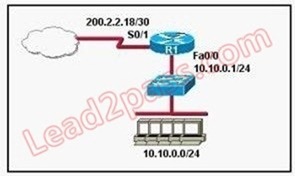
A. R1(config)# interface serial0/1
R1(config-if)# ip nat inside
B. R1(config)# interface serial0/1
R1(config-if)# ip nat outside
C. R1(config)# interface fastethernet0/0
R1(config-if)# ip nat inside
D. R1(config)# interface fastethernet0/0
R1(config-if)# ip nat outside
E. R1(config)# interface serial0/1
R1(config-if)# ip nat outside source pool 200.2.2.18 255.255.255.252
F. R1(config)# interface fastethernet0/0
R1(config-if)# ip nat inside source 10.10.0.0 255.255.255.0
Answer: BC
If you use Lead2pass braindump as your 200-105 exam prepare material, we guarantee your success in the first attempt. Lead2pass 200-105 dump provides you everything you will need to take your 200-105 Exam.
200-105 new questions on Google Drive: https://drive.google.com/open?id=0B3Syig5i8gpDY2V1UExCV21ZUHM
2016 Cisco 200-105 exam dumps (All 346 Q&As) from Lead2pass:
http://www.lead2pass.com/200-105.html [100% Exam Pass Guaranteed]